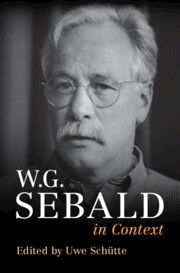Book contents
- W.G. Sebald in Context
- W.G. Sebald in Context
- Copyright page
- Dedication
- Contents
- Illustrations
- Notes on Contributors
- Preface
- Acknowledgements
- Note on Text
- Chronology
- Abbreviations
- Works by W.G. Sebald
- Part I Biographical Aspects
- Chapter 1 Allgäu
- Chapter 2 Grandfather
- Chapter 3 Manchester
- Chapter 4 East Anglia
- Chapter 5 Academia
- Chapter 6 The British Centre for Literary Translation
- Chapter 7 Between Germany and Britain
- Part II The Literary Works
- Part III Themes and Influences
- Part IV Reception and Legacy
- Further Reading
- Index
Chapter 4 - East Anglia
from Part I - Biographical Aspects
Published online by Cambridge University Press: 24 August 2023
- W.G. Sebald in Context
- W.G. Sebald in Context
- Copyright page
- Dedication
- Contents
- Illustrations
- Notes on Contributors
- Preface
- Acknowledgements
- Note on Text
- Chronology
- Abbreviations
- Works by W.G. Sebald
- Part I Biographical Aspects
- Chapter 1 Allgäu
- Chapter 2 Grandfather
- Chapter 3 Manchester
- Chapter 4 East Anglia
- Chapter 5 Academia
- Chapter 6 The British Centre for Literary Translation
- Chapter 7 Between Germany and Britain
- Part II The Literary Works
- Part III Themes and Influences
- Part IV Reception and Legacy
- Further Reading
- Index
Summary
This essay discusses the role of East Anglia in the biography and literary works of Sebald. Sebald lived from 1970 until his premature death in 2001 in the eastern part of England, whose charm as a remote stretch of land has left its mark in his writings in many ways. As early as 1974, Sebald published a travelogue in the travel section of the newspaper Die Zeit, describing ‘A Leisurely Tour through Norfolk and Suffolk’. This journalistic piece anticipated the portrayal of East Anglia in his later narrative texts. Similarly, East Anglia repeatedly became a theme in Sebald’s poetry with motifs returning in the later prose. The essay focuses on After Nature and The Rings of Saturn, but also includes Austerlitz and the Corsica Project. To conclude, it examines the extent to which Sebald’s account can be understood as a faithful description of East Anglia, or rather, as the essay argues, as a poetic portrait of the area that constituted Sebald’s second “Heimat”.
Keywords
- Type
- Chapter
- Information
- W. G. Sebald in Context , pp. 30 - 39Publisher: Cambridge University PressPrint publication year: 2023

